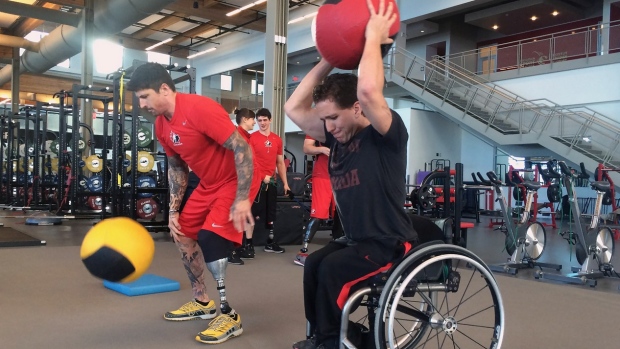Jan 16, 2015
Canada's sledge hockey team hits the gym
Core strength is a sledge hockey player's money maker. When Canada's players go into the gym, they expect to leave with their stomach muscles aching. "If you go to where your muscles literally can't go any more, you'll make real big gains," says forward Greg Westlake.
The Canadian Press

CALGARY - Core strength is a sledge hockey player's money maker. When Canada's players go into the gym, they expect to leave with their stomach muscles aching.
"If you go to where your muscles literally can't go any more, you'll make real big gains," says forward Greg Westlake. "You want to fail every time. Part of being an elite athlete versus a weekend warrior is pushing yourself to failure."
Back and arm strength matters in a sport where hockey players propel themselves on sledges using two picks, but the hard, about-face turn when the puck changes possession requires a powerful trunk to re-direct the sledge.
So those battle-rope drills so popular on sports drink commercials now are part of the sledge team's dryland training routine. From their wheelchairs or on their prosthetic legs, they whip the ropes above their heads and yank them down.
Another drill is using one arm to pull a rope attached to a heavy chain while in a push-up position, and then switching to the other arm.
"One of the best things right now is there's a big trend for the battle ropes," Westlake says. "We have real heavy ones.
"The most important muscle groups in terms of just power would be your back, triceps and your core. Your whole upper body is important because you need the balance and you don't want to get injured."
The Canadian sledge team has two titles to defend in 2015. Canada will compete Feb. 1-7 in the World Sledge Hockey Challenge in Leduc, Alta., followed by the world championship April 24 to May 2 in Buffalo, N.Y.
The Canadians won bronze at the 2014 Winter Paralympics in Sochi, Russia.
At a training camp in Calgary this week, strength and conditioning coach Chris Osmond put the 19 players from Summerside, P.E.I., to Quesnel, B.C., team through circuit training at Canada Olympic Park.
It was Osmond's first time working with the national team. He wanted to send each athlete home knowing exactly what muscle groups require attention.
"The big thing is core, upper-body strength, upper-body power," Osmond said.
But before the athletes even got to the power part of their workout, they spent a lot of time stretching out their upper bodies. The wheelchair athletes put strain on their shoulders just wheeling around in daily life.
So the first piece of equipment forward Billy Bridges grabs at the gym is a foam roller to roll out his shoulder and back muscles. The second item he'll pick up is an elastic rope to loosen up his rotator cuffs.
"It seems like every day is a battle for posture and getting your back realigned," Bridges says. "There's so much strain on your shoulders that if you don't keep those strong, we're not going to have much longevity in this sport."
As in able-bodied hockey, the sledge player needs the aerobic fitness to quickly recover from one shift to the next. Westlake, a 28-year-old from Oakville, Ont., is an advocate of lean muscle mass.
"It's a cardio-based sport. You've got to be in shape to play," he says. "We've had guys who have made this team who are muscle-bound ... and maybe their cardio isn't up to par. Maybe they're too heavy and it's hard to pull yourself.
"You've got to find the weight that works for you and then you've got to build off that. Get as strong as you can at the lightest weight you can be."
Adds Osmond: "Sledge hockey is no different from able-bodied hockey. Sure you're using your anaerobic system, but that's all driven by your aerobic system. You need a big engine. If you can't keep it going, then you're not going to be an impact player for your team."
Bridges is bulkier than Westlake, which the 30-year-old from Summerside says fits his power forward game.
"When I was first on the team, I was 14 and 95 pounds and that was fine," he said. "There was hitting, but we weren't moving that fast. Now people are joining this sport at a younger age and training hard at a young age, so we have guys like Ben Delaney pushing the boundaries of what's possible.
"With me, I like being big. I play a big game and I feel the stronger I can be, the harder it is to knock me off the puck."
Bridges plays wheelchair tennis and Westlake kayaks as cross-training for sledge hockey.
Both are veterans of the national sledge team having won Paralympic gold in 2006. They say competing at that level requires three to five sessions a week in the gym in addition to almost daily on-ice practices.
"The athletes are getting better, the technology is improving and the sport is becoming more competitive," Westlake says.
"Just because it's team sport, it's hard to quantify how good everybody is. It's so much faster and so much better than it was 10 years ago. I'm finally at that point where young guys are coming in and pushing me. They're fast and fit and it's a really fun thing to be a part of."
